Globe stereothermometer – a new instrument developed in Occupational Safety Research Institute in Prague
Kulový stereo teploměr - nový přístroj vyvinutý ve VÚBP Praha
Miloslav V. Jokl1, Stanislav Malý3, Zdeněk Jirák2, Hana Tomášková4, Daniel Šebesta1
1 Czech Technical University , Prague, miloslav.jokl@fsv.cvut.cz
2 University of Ostrava, zdenek.jirak@osu.cz
3 Occupational Safety Research Institute, Prague, malys@vubp-praha.cz
4 Institute of Public Health in Ostrava, hana.tomaskova@zuova.cz
Abstract
According to EN ISO 7730 the estimation of RTA (trA-trB) is prescribed; it has been measured by Indoor Climate Analyzer of Bruel and Kjaer. It was proved that a new instrument, globe stereothermometer, developed in Malý´s research group, can be applied for this purpose.It is a globe of 15cm in diameter divided into 6 segments; the surface temperature of each segment is called stereotemperature (tstereo). The mean value of all six stereotemperatures equals to globe temperature (tg). Radiant Temperature Asymmetry can be estimated from equations (6),(7)and (8) and from Fig. 7.Stereothermometer is produced by SIPOCH Ltd. Prague. The company also developed electronics and technology of the instrument (dipl. Ing. L. Vajner). This paper introduces new method for radiant temperature asymmetry estimation.
Keywords: radiant temperature asymmetry, local comfort criteria, thermal comfort
Abstrakt
Dle EN ISO 7730 je předepsáno hodnocení RTA (trA-trB). Měření bylo provedeno v analytickém zařízení vnitřního klimatu. Bylo potvrzeno, že nový nástroj, tj. stereoteploměr, který byl vyvinut ve výzkumném týmu Dr. Malého, může být pro tento účel aplikován. Je to koule o průměru 15 cm, která je rozdělena do šesti segmentů; plošná teplota každého segmentu se nazývá stereoteplota (tstereo). Průměrná hodnota všech šesti stereoteplot je rovná teplotě koule (tg). Asymetrie sálavého tepla může být vyčíslena z rovnic (6), (7) a (8) a z obrázku č. 7. Stereoteploměr je vyráběn SIPOCH, s.r.o. Praha. Tato společnost vyvíjela rovněž elektroniku a příslušnou techniku tohoto nástroje (Ing. L. Vajner). Tento příspěvek představuje novou metodu hodnocení asymetrie sálavého tepla.
Klíčová slova: sálavé teplo, tepelná zátěž, komfort, stereoteploměr
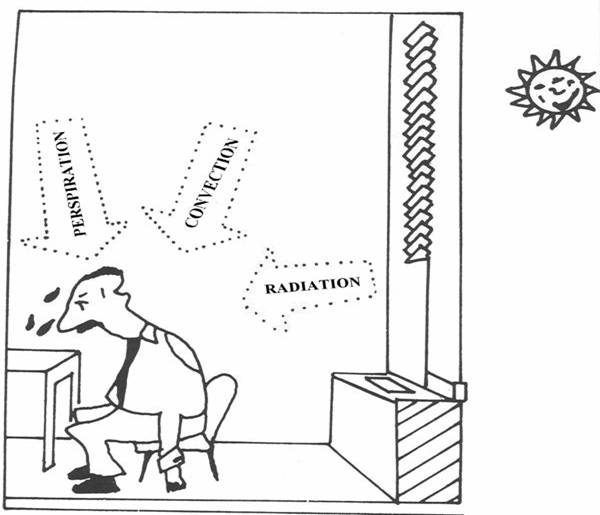
Figure 1. One side irradiation at the workplace from the window
Introduction
The so called Radiant Temperature Asymmetry (RTA) is the recommended criterion for non-uniform thermal load on human body, e.g. from radiating window (Fig. 1), heated floor, heated or cooled ceiling, the workplaces at furnaces in iron and glass works, by the standard EN ISO 7730. It is valid for three categories A, B, C depending on various predicted percentage of dissatisfied people (PPD): A is the most comfortable, for the lowest PPD, C for the highest PPD. An example of prescribed values of RTA is presented in Tab. 1 (Tab. A4 EN ISO 7730) (JOKL, 2002)(PETRÁŠ…[et al.], 2004).
Table 1. RTA by EN ISO 7730:2005
| Category | Radiant Temperature Asymmetry - RTA | |||
|---|---|---|---|---|
| Warm ceiling | Cool wall | Cool ceiling | Warm wall | |
| A | < 5 | < 10 | < 14 | < 23 |
| B | < 5 | < 10 | < 14 | < 23 |
| C | < 7 | < 13 | < 18 | < 35 |
The estimation of RTA up to now
RTA is measured up to now by Indoor Climate Analyzer type 1213, Bruel and Kjaer, Denmark. There is a special sensor for this purpose with this instrument, so called RTA (Radiant Temperature Asymmetry) transducer MM 0036 (Fig. 2), By means of PT100 radiant heat is estimated coming from two opposite sides A and B: surface temperatures trA and trB of a small plane are measured and their difference (trA - trB) is the RTA.
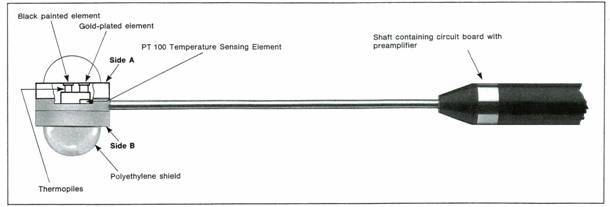
Figure 2. RTA transducer (MM 0036) of Indoor Climate Analyzer from Bruel and Kjaer
A new way of RTA estimation
It is based on a new instrument application, the so called globe stereothermometer.
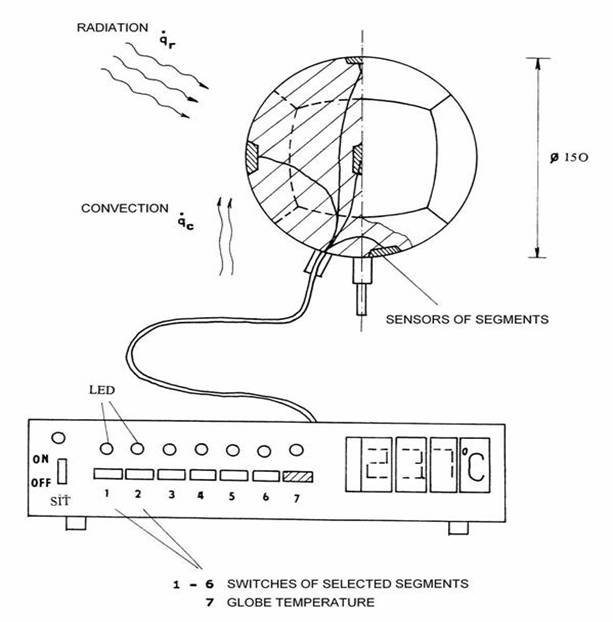
Figure 3. Globe stereothermometer scheme
Principle of stereothermometer
First have a look at an ordinary globe thermometer (GT). There is a big difference in success of GT and other instruments, developed for the same purpose: GT is used from the year 1923 continuously as a part of many national standards, government directives and hygienic prescriptions. There is a simple reason for it: – GT does not try to be a model of human body, it is only a part of human body thermal equilibrium equation, operative temperature can be substituted by globe temperature. Of course, globe temperature includes exactly only air and radiant temperature thus as a criterion of human comfort the relationship on other factors must be taken into account, on air velocity and humidity, clothing, activity, adaptation and exposure time.
What is valid for the whole GT can be written approximately also for a part of it, for its segment. For GT of 15cm in diameter six segments have been proved quite satisfactory (originally 18 segments were tested). The surface temperature of each segment is called stereotemperature, i.e. the mean value of all six stereotemperatures equals globe temperature.
For the scheme of instrument see Fig. 3 and Fig. 4 there is a photo. It is produced by SIPOCH Ltd. Prague. The company also developed electronics and technology of the instrument (dipl. Ing. L. Vajner).
Supposing a) the equality of heat transfer coefficients for irradiated and non-irradiated segment, b) the stereotemperature of non-irradiated segment equals globe temperature, the simple equation based on segments heat balance can be derived
![]()
![]()
where trA - trB RTA [°C]
tstereo stereotemperature, i.e. temperature of exposed segment [°C]
tg globe temperature [°C]
hc heat transfer coefficient by convection [W-1.m2.K]
hr heat transfer coefficient by radiation [W-1.m2.K]
These equations cannot be applied in practice because the calculation of heat transfer coefficients is a difficult problem. Therefore the experimental estimation of equations is necessary.
Experimental estimation of the relationship between RTA and the difference stereotemperature minus globe temperature
The impact of vertical and horizontal surface has been tested in the climatic chamber (dimensions 3x2x2 m) (Fig. 5). Keeping globe temperature constant 24 °C the temperatures of the vertical surfaces was chosen 14, 19, 24, 29, 34 a 44 °C ,the temperatures of the horizontal surfaces 45, 53 a 58 °C (Tab. 2).
Tab. 2 Conditions in climatic chamber
| Vertical radiant surface | Horizontal radiant surface | |||||||||||
|---|---|---|---|---|---|---|---|---|---|---|---|---|
| Exp.No. |
tg (oC) |
trA (oC) |
Δ trA-tg (oC) |
Exp.No. |
tg (oC) |
trA (oC) |
Δ trA-tg (oC) |
Exp.No. |
tg (oC) |
trA (oC) |
Δ trA-tg (oC) |
W/m2 |
| 1 | 24 | 24 | 0 | 4 | 24 | 29 | +5 | 7 | 24 | 45 | 21 | 100 |
| 2 | 24 | 14 | -10 | 5 | 24 | 34 | +10 | 8 | 24 | 53 | 29 | 150 |
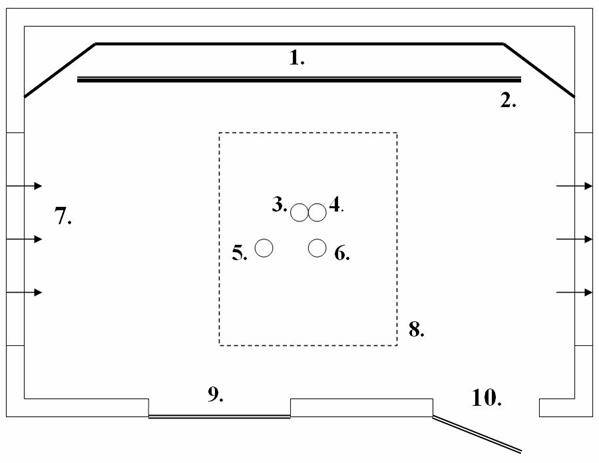
Figure 5. Measurements in climatic chamber, where 1. vertical warm radiant panel, 2. vertical cool radiant panel, 3. radiant temperature, 4. stereothermometer, 5. air velocity, 6. globe thermometer Vernon-Jokl, 7. direction of air flow, 8. ceiling radiant panel, 9. control room window, 10. entrance.
RTA, trA, trB, air flow velocities( chosen 0.25 m/s, 0.5 m/s a 1.0 m/s) air temperatures, relative air humidities were measured by Indoor Climate Analyzer Type 1213(Bruel and Kjaer) respecting EN ISO 7726.
The stereotemperatures tstereo (the temperature of the exposed segment) and globe temperature were measured by stereothermometer.
The results are presented in Fig. 6 a 7.
The temperature trA (temperature of the irradiated plane side) against the stereotemperature (temperature of the irradiated segment) for three velocities (0.25 m/s, 0.5 m/s and 1.0 m/s) is presented in Fig. 6. Correlation coefficients are high (R2=0.9797 up to 0.9908), thus the graph can be applied to practice for the estimation of trA on the basis of measured stereotemperature
trA= 3.4153 tstereo-57.004 [°C] for v=0.25 m/s (3)
trA= 4.14 tstereo-74.971 [°C] for v=0.5 m/s (4)
trA= 5.46 tstereo-108.33 [°C] for v=1.0 m/s (5)
RTA (=trA - trB) depends on the difference stereotemperature minus globe temperature (tstereo minus tg), see Fig. 7.and following equations:
trA-trB= 3.6242(tstereo – tg) – 0.5098 [°C] for v=0,25 m/s (6)
trA-trB= 4.3807(tstereo – tg) – 1.3907 [°C] for v=0.5 m/s (7)
trA-trB= 5.1507(tstereo – tg) – 0.2010 [°C] for v=1.0 m/s (8)
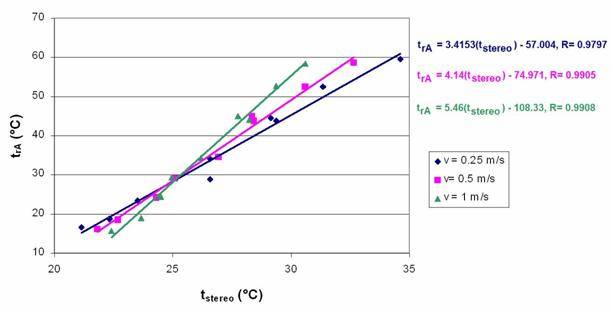
Figure 6. Relationship trA=f(tstereo) for various v from experiments
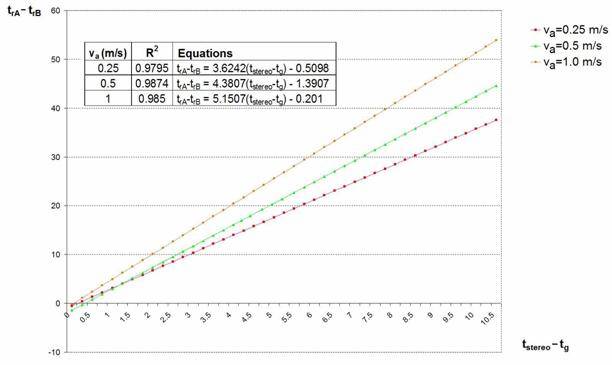
Figure 7. Relationship RTA = trA-trB= f(tstereo-tg) from experiments.
Discussion
The estimation of RTA has been possible only by Indoor Climate Analyzer (Bruel and Kjaer) up to now. The instrument is highly sophisticated and thus expensive. A new instrument, globe stereothermometer, can be also used for this purpose being much more simple and thus cheaper. Electronics and technology of this instrument was also a problem; being solved enough is now produced professionally by SIPOCH Company.
Conclusion
The new instrument - globe stereothermometer – is a globe of 15cm in diameter divided into 6 segments; the segments temperature is called stereotemperature. Based on measurements in climatic chamber it has been proved that instrument allows estimation of RTA from the difference tstereo minus tg , see Fig.7 and equations (6),(7)and(8).
References
EN ISO 7726. Ergonomics of the thermal environment-Instruments for measurements of physical quantities. 1998.
EN ISO 7730. Ergonomics of the thermal environment – Analytical determination and interpretation of thermal comfort using calculation of the PMV and PPD indices and local comfort criteria. 2005.
JIRÁK, Z.; JOKL, M. V., ŠEBASTA, D.; TOMÁŠKOVÁ, H., BERNATÍKOVÁ, Š.; MALÝ, S. 2007. Use of Globe Stereo Thermometer for Evaluation of Irregular Radiation Load. Central European Journal of Public Health, 2007, Supplement, vol. 15 (JHEMI vol. 51), p. S24.
JOKL, M. V. 1966. The way of infrared heat load estimation over the human body surface.In Cech, Patent No. 117894, Prague.
JOKL, M. V.; TŮMA, V. 1988. Directional globe thermometer. In Czech.Patent No.236203.Prague.
JOKL, M. V. 1990. The stereothermometer: A new instrument for hygrothermal constituent nonuniformity evaluation. ASHRAE Transactions 96, 1990, No. 3435, p. 13-18.
JOKL, M. V. 1991. Feuchtemessung nach “Kunstkopf” : prinzip. Heizung-Luftung-Haustechnik, 1991, vol. 42, no. 1, p. 27-32.
JOKL, M. V. 1991. Stereoteploměr : nový přístroj pro hodnocení nerovnoměrnosti tepelně-vlhkostní konstituenty prostředí. Československá hygiena, 1991, vol. 36, no. 1, p. 14-23.
JOKL, M. V. 2002. Health Residental and Working Environment. Prague : Czech Academia, 2002.
JOKL, M. V.; VAJNER, L. 2003. Globe Thermometer : Useable Pattern No. 13547. Written down 1.8.2003. Owner VÚBP Prague.
PETRÁŠ, D., KOUDELKOVÁ, D.; KABELE, K. 2004. Hydronic and Electrical floor Heating. Bratislava : Czech. Jaga,, 2004.
Užitečné odkazy
Provozovatel portálu
Jeruzalémská 1283/9
110 00 Praha 1


